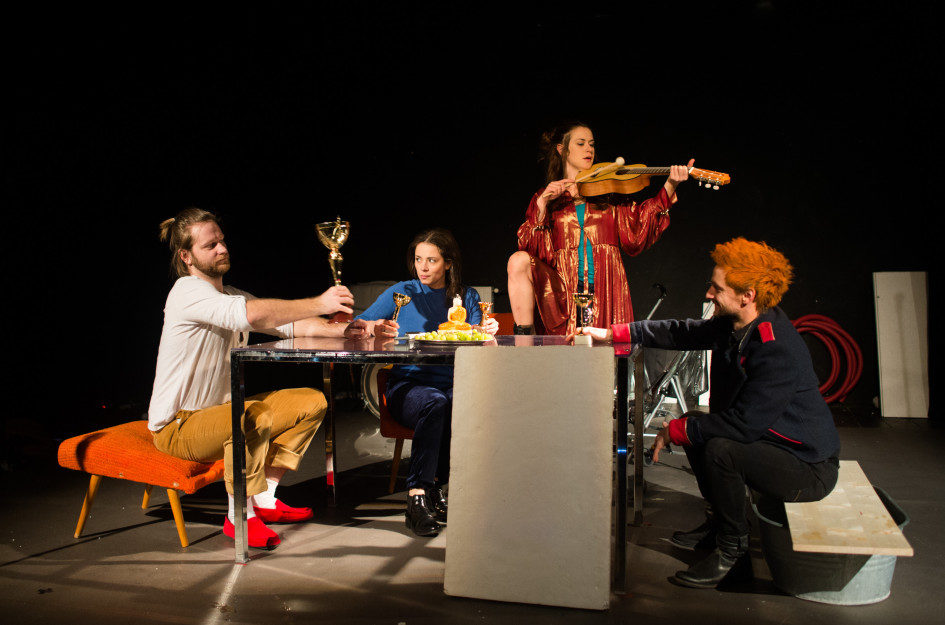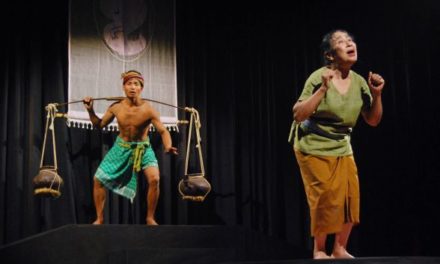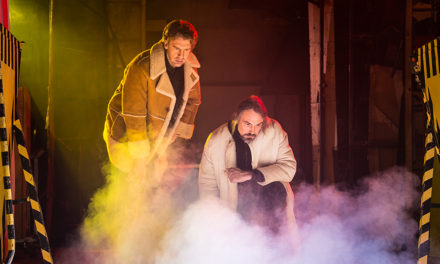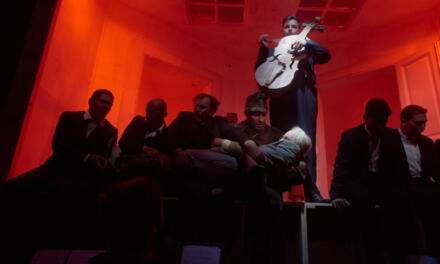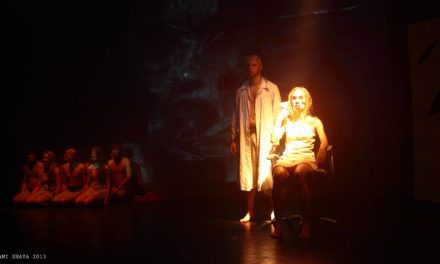In the 2015 Divadelná Nitra International Festival bulletin, the curators of the Slovak section of the program–Michal Ditte and Iveta Ditte Jurčová–published the Report On The State of Slovak Theatre. They accused some Slovak theatres of having given up on the real world, the world beyond the walls of the theatre buildings. They also accused them of following patterns of audience attractiveness when creating their repertories. A year and a half after the publication of the report, Slovak theatres started a process of transformation.
There has been much movement in state-funded institutions as well as in an independent theatre. Contemporary drama (i.e. texts not older than twenty years), rarely produced in the past, is now a full-fledged and often predominant part of their repertory. Even a brief look into the dramaturgy plans of Slovak theatres makes it clear that the productions from the period the current Nová dráma/New Drama festival covers (February 2016 to January 2017) are qualitatively much better than “the classics.”
However, it would be misleading to speak about a boom in new drama. The more than sixty productions the dramaturgy board viewed included many genres. There were adaptations of contemporary and classical fiction, film adaptations, dramatic texts commissioned by Slovak theatres and written by Slovak authors, devised texts created collectively, and international drama. In addition to famous names in German theatre, such as Dea Loher (Innocence, Slovak National Theatre), Falk Richter (Delirium and God Is a DJ, DPM Theatre) and Roland Schimmelpfennig (Idomeneus, City Theatre Žilina), international plays mostly included “sure bets.” Light, though skilfully written, plays by Sarah Ruhl (Vibrator Play, Aréna Theatre), Albert Ramsdell Gurney (Sylvia, Astorka Korzo ’90 Theatre), Elaine Murphy (Little Gem, State Theatre Košice), Zoltán Egressy (Offside, Jonáš Záborský Theatre Prešov), among others, are good and relevant examples.
SLOVAK DRAMA AND ITS “HEROES”
But the development in original Slovak drama is wholly different. Recently, most of the work done by Slovak playwrights have been commissioned. The Drama Department of the Slovak National Theatre is especially active in this respect. It initiated the origination of several new productions and one text collage (Morals 2000+). And although the results did not quite meet expectations, this attitude showed a great level of trust towards Slovak authors. The prototype of the Slovak hero is changing just like Slovak society is changing. The typical Krcheň (Eva Maliti Fraňová: Krcheň The Immortal, 2001), a relic of the previous regime and a man with the desire to become a dauntless ruler, has disappeared at the expense of characters who are much more difficult to judge. “Dobroslav” from Kerata’s play Dobro (Andrej Bagar Theatre Nitra) is an embodiment of virtue and a true ideal. It is a shame that he is easily taken advantage of by those, who have realized that the European Union is good for business.
Typical characters of today are also the brothers Billy and Jeff (Lenka Garajová: Death Of A ©, City Theatre Žilina), regular young boys yearning for the strongest drugs of the capitalist society – financial and career success. We live in an era of rivals – the vicious leftist intellectual Andrej, who has a great sense for entrepreneurship, and Dodo, a fanatical right-wing extremist (Pavol Weiss: From the Life of Mankind, Slovak National Theatre). The final touch to the local color of Slovak characters is provided by ambiguous weirdoes struggling with dilemmas of European dimensions. These are the characters from adaptations of the essential world literary works of today. One of these characters is François (Submission, Aréna Theatre), lacking any values and emptied both intellectually and emotionally. He does not hesitate to leave his Christian roots and convert to Islam.
THE PAST AND THE PRESENT
But theatremakers do much more than just create theatre. The Pôtoň Theatre, the Puppet Theatre on the Crossroads, and the Drama Department of the Slovak National Theatre all reject right-wing extremism. They all fight for the values of democratic society by means of doing socially committed projects. Last year, also other theatres took up this attitude. In the Jozef Gregor Tajovský Theatre in Zvolen and in the New Theatre in Nitra, ensembles produced Anne Frank’s Diary. They created the pieces as an imperative intended mostly for the young generation and raising a warning finger about repeating history.
The Theatre NA PERÓNE’s devised production Heil Scholarship! discusses how open our society is towards foreigners. A warning against new totalitarianism is introduced in the dramatization of Yefim Zozulya’s short stories. It was produced by the Splinter In The Eye theatre and called The Life of Man. And although theatremakers prefer the simple, poster-like communication of an opinion to a more complex analysis or attempts at documentary approach (so popular in the world), the boom of dramaturgy with a clear social viewpoint is apparent.
Theatre art is still very fond of looking back into the past. But this approach has transformed into providing alternative views of history with very topical commentary. Peter Esterházy’s play Mercedes Benz (by the Slovak National Theatre) describes the hardship of the noble Esterházy family in Slovakia through the eyes of one of the family’s descendants. Another example is the production On a Chicken’s Wings (Bratislava Puppet Theatre), which caused a great uproar. This piece is based on the novel by Irena Brežná and directed by Katarína Aulitisová. It is a reminiscence of the era of socialism from the point of view of a school girl, a play featuring humor similar to the movie Cosy Dens. The play has become an exceptional work of art among puppet productions in Slovakia. It is one of the rare attempts to break the typical Slovak stereotype which considers puppet theatre to be solely for children.
The present times are reflected in a more general sense in contemplative theatre. Peter Lomnický’s Fear (Slovak National Theatre) and the expressive style of director David Jařab reflects the anxieties of modern people who cannot understand the complex world of today. A similar approach, though much lighter and more playful, is visible in Roland Schimmelpfennig’s Idomeneus. Its charms reside in the spectacularly simply direction of Eduard Kudláč, which deconstructs the story of an ancient myth.
THE NEW GENERATION
The youngest generation of artists takes a very distinct approach. However, they are also united by the current state of affairs. The present times are like a series of earthquakes which have demolished their ideals. The open arms offering too many possibilities will eventually smack everyone who tries to embrace them. The productions Super End (Lýdia Petrušová and a team of artists), The Day When Gott Died (Prešov National Theatre), PEOPLE.LIONS.EAGLES.PARTRIDGES (Tomáš Procházka et al.), and God Is a DJ (DPM Theatre) portray the frustration of young people on the edge of adulthood. All these pieces reflect the uncertainty of material security, disintegrating emotional bonds, an inability to make dreams come true, or at least exist normally. In addition to the constantly devising theatres, such as Stoka, SkRAT, GUnaGU and NA PERÓNE, there are now individuals and new groups who base their art on the authenticity of their experience.
One of the formally radical productions created by young artists is the first instance of immersive theatre in Slovakia – Delirium by Falk Richter. The Peter Mankovecký Theatre presented the devised and adjusted text under the title Delirium (Christmas in Stalkville). Director Petra Tejnorová staged the play on the premises of an unreconstructed building on Laurinská Street in Bratislava. Sadly, the production was presented only several times and, despite its elaborate design, only became an experience for a chosen few.
A special category is made up of other works that defy any genre or typological limitations. They transgress classical interpretational theatre and shift their focus towards performance or visual installation. They move freely between several art disciplines: theatre and visual art, contemporary dance and music. Beauty and Filth (Honey and Dust), Orwell’s Principles of Newspeak (Studio 12), Bad Gesture (Non.Garde) as well as Tracks in Memory (Odivo) – they all stretch the boundaries of theatricality and pose questions about the selection criteria for the Nová dráma/New Drama festival.
But this view of Slovak theatre grossly idealizes it. A considerable part of the repertory of bricks-and-mortar theatre is ade up of boulevard plays or skilful dramatizations. There seems to be no attempt to make any contact with current issues. However, as festival dramaturges, we did not have to rummage through piles of plays to find truly precious subjects. We have uncovered a whole range of preferences of contemporary directors and artists of all generations when choosing their topics and production poetics.
Slovak theatremakers–when working individually or commissioned by theatres–think about themselves, about the past and about the times they are living now. Their work reflects and cultivates the society that surrounds them. They do this whether they give cynical messages, show the reality as a problem or make it appear relative, or call upon positive values. The number of productions that are eligible for the Nová dráma/New Drama festival keeps growing. Along with it, there is also an increasingly intense reflection of contemporary issues. This is, to say the least, a positive signal for the future.
This post was written by the author in their personal capacity.The opinions expressed in this article are the author’s own and do not reflect the view of The Theatre Times, their staff or collaborators.
This post was written by Milo Juráni.
The views expressed here belong to the author and do not necessarily reflect our views and opinions.

